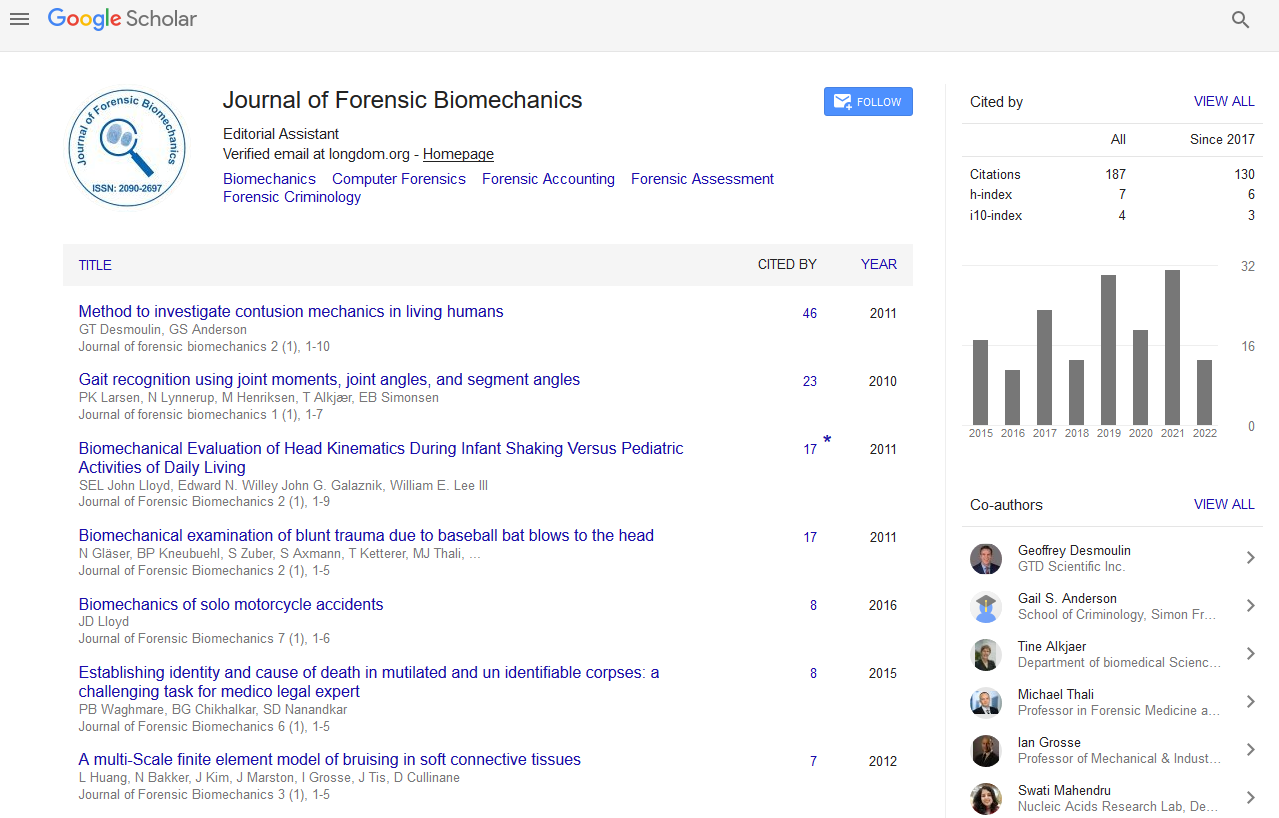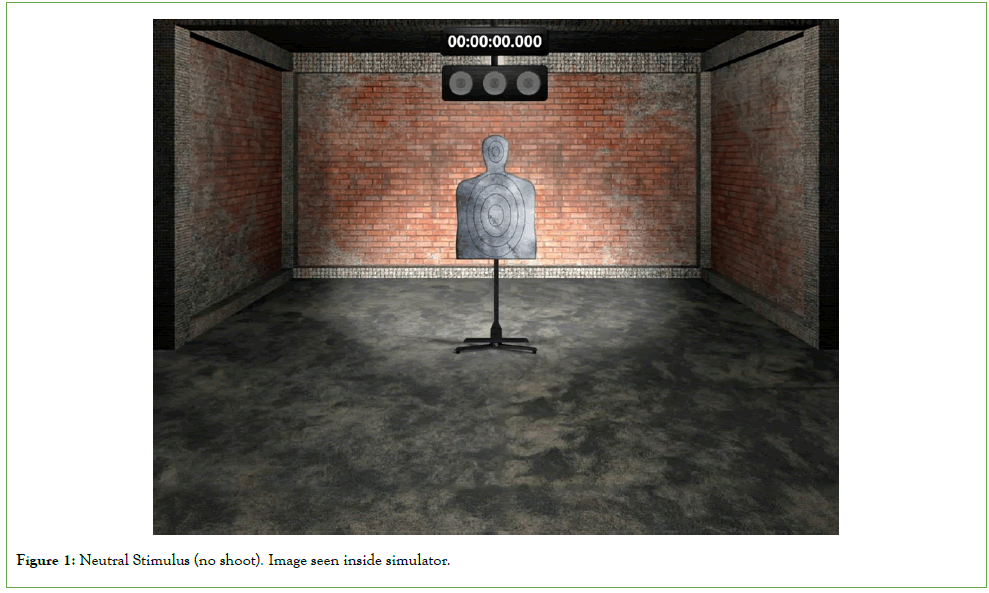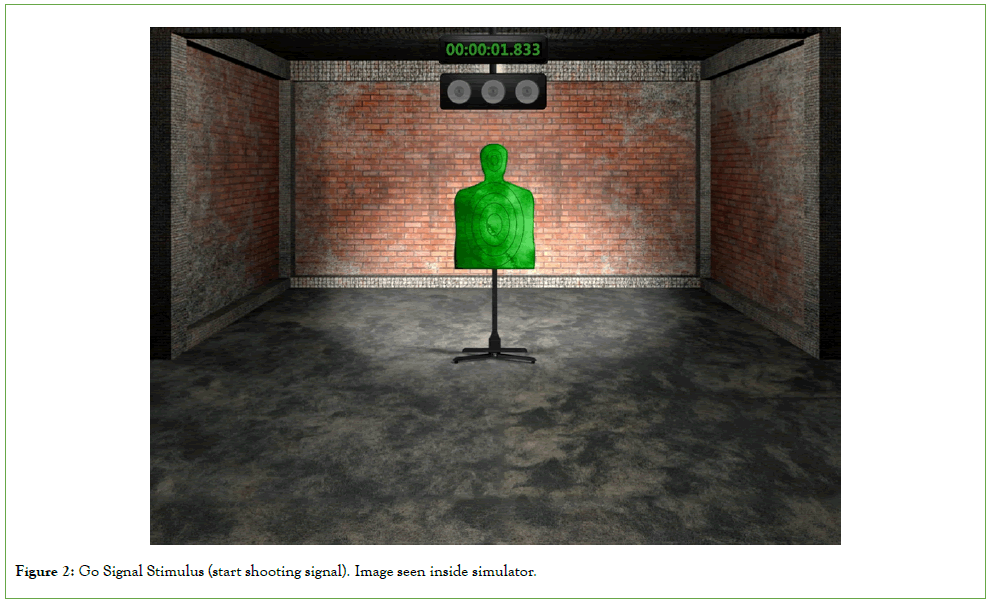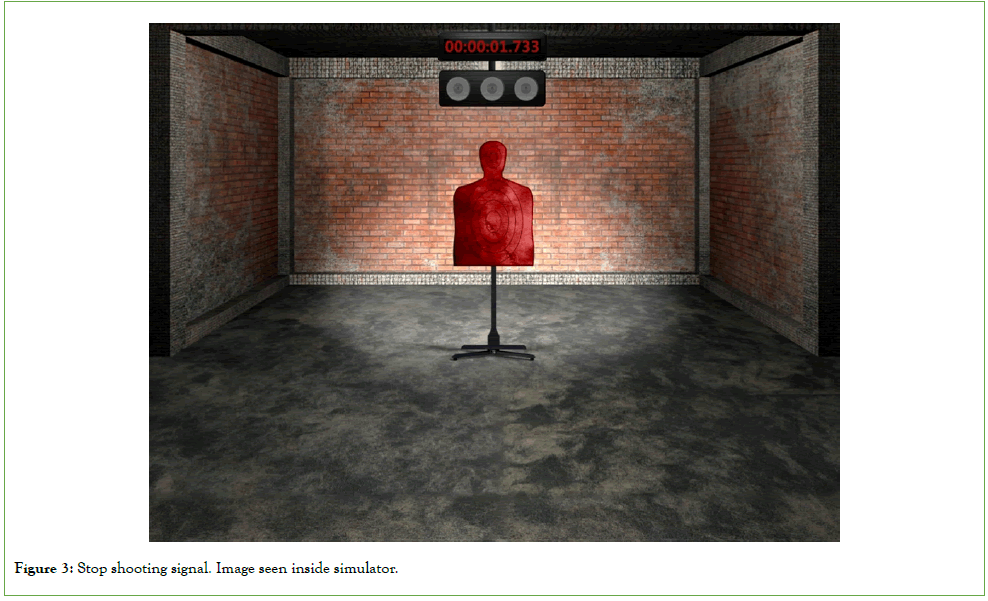Indexed In
- Genamics JournalSeek
- SafetyLit
- Ulrich's Periodicals Directory
- RefSeek
- Hamdard University
- EBSCO A-Z
- Geneva Foundation for Medical Education and Research
- Euro Pub
- Google Scholar
Useful Links
Share This Page
Journal Flyer
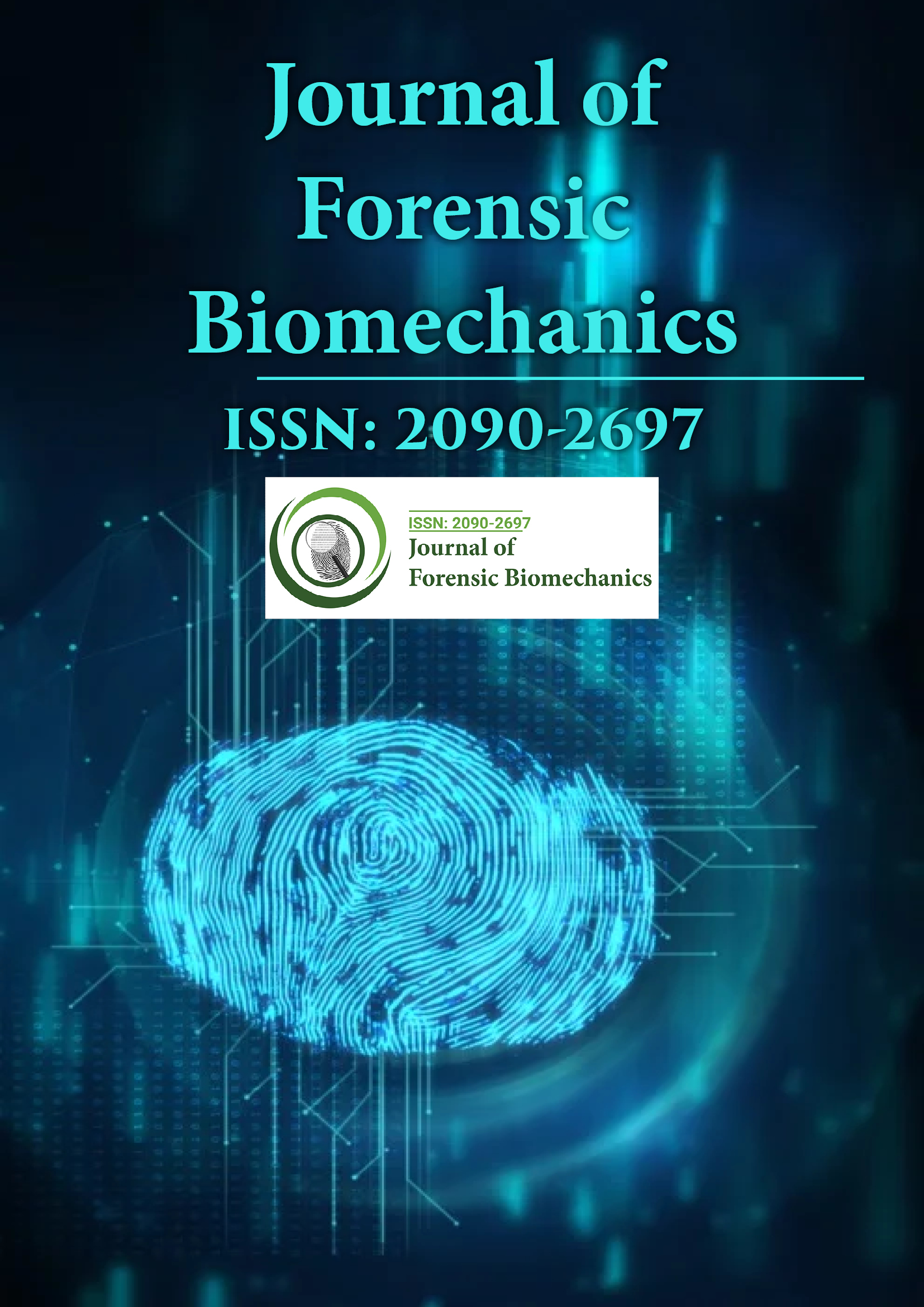
Open Access Journals
- Agri and Aquaculture
- Biochemistry
- Bioinformatics & Systems Biology
- Business & Management
- Chemistry
- Clinical Sciences
- Engineering
- Food & Nutrition
- General Science
- Genetics & Molecular Biology
- Immunology & Microbiology
- Medical Sciences
- Neuroscience & Psychology
- Nursing & Health Care
- Pharmaceutical Sciences
Research Article - (2025) Volume 16, Issue 1
Time to Stop: Firearm Simulation Dynamics
Lon D. Bartel1, Nicole M. Florisi2*, Von Kliem2, Tom Cameron1, Miranda Fuller1 and Jeff Knaup12Force Science, Chicago, United States of America
Received: 14-Jan-2025, Manuscript No. JFB-25-28295; Editor assigned: 16-Jan-2025, Pre QC No. JFB-25-28295 (PQ); Reviewed: 30-Jan-2025, QC No. JFB-25-28295; Revised: 06-Feb-2025, Manuscript No. JFB-25-28295 (R); Published: 13-Feb-2025, DOI: 10.35248/2090-2697.24.16.510
Abstract
This study focused on the perceptual, cognitive, and physiological processes involved in the perception-reaction phases of shooting and then stopping in response to stimuli. Utilizing a police/military training simulator, the researchers aimed to understand the lag between the presentation of a stop stimulus and the actual cessation of the action. Participants, predominantly college-aged adults, engaged in a shooting exercise using a VirTra simulator with a CO2-powered Glock 17, simulating the recoil and firing of a live weapon. The scenario required them to shoot at a target that changes color from green (start) to red (stop), with the researchers recording the number of rounds fired after the stop signal and the timing of these shots. The findings indicated a delay in stopping the shooting action, reflecting the psychological and motor response complexities in similar dynamic events. The study contributes to understanding the critical timing in perception and action execution/cessation in simulated firearm use, providing insights into training and the dynamics of use-of-force situations. This research underscores the complexity of perception reaction times in real-world situations and the potential for technology-based simulations to study and improve training methods in law enforcement and military settings.
Keywords
Perception-reaction time; Shooting cessation; Police/military training simulation; Use-of-force dynamics; Firearm training simulator; Motor response delay
Introduction
Recent police shootings have raised questions not only as to when an officer must legally stop shooting, but how long it can take to physically stop once they have made that decision [1]. In Hernandez v. City of Los Angeles, the officer involved in the shooting was a competition shooter. The number of rounds fired by the highlyskilled officer became the focus of controversy. In Hernandez, the officer’s skill, experience with firearms, and human performance capabilities were central to deciding whether her decision-making and performance were “reasonable.”
Many factors can influence the time for an officer to start shooting. The officer’s focus of attention and level of awareness can be significant contributors. If the officer fails to recognize a of threat stimuli, there will be a delay in response if there is a response at all. If the officer has their attention focused internally, such as worrying about their safety or ability, they could be delayed in processing and responding to external stimuli (i.e., the threatening behavior), [2]. The question then is, if there is a delay in starting to shoot (or responding with any human movement), could there be a delay in stopping?
It follows that, if an action takes time to start, it also takes time to stop. Research into the electrical signals generated by muscle fibers when they contract (Electromyography or EMG), indicates that stopping a response may not be possible if EMG activity is present prior to the brain’s signal to stop [3]. For example, if EMG activity is already present in the officer’s firing arm or hand before they perceive a suspect’s surrender, stopping the trigger pull may be physiologically impossible. Once the officer begins to execute the decision to shoot, it takes time to stop [4]. It is reasonable to expect that any actions (e.g., trigger pulls) initiated many continue to be performed in during that “time to stop” period.
In a law enforcement shooting scenario, the officer filters through a multitude of environmental stimuli. Some information is relevant to the event, while others may be response delaying distractions. In cognitive psychology, the Eriksen flanker effect”, describes how distracting stimuli, or “flankers”, can cause a response delay when a visual stimulus indicating the correct reaction is accompanied by irrelevant and misleading cues (i.e., deceptive cues) [5].
In a shooting scenario, distractions in the officer’s visual field (e.g., bystanders running, other officer movements, dynamic suspect movements) can interfere with an officer’s perceptions of a suspect’s surrender or incapacitation. When an officer’s brain is processing previous threat indicators, it can be harder to quickly recognize and credit a change in the suspect’s behavior. This phenomenon can result from the simultaneous processing of relevant and extraneous stimuli, leading to a subsequent competition and potential delay in response [6].
The Psychological Refractory Period (PRP) can also help explain certain response delays in high-stress, officer-involved shootings. The Psychological Refractory Period (PRP) is the short delay in the ability to react to a second stimulus when your brain is still processing the first one.
Research suggests that during the PRP, there is a bottleneck in information processing, which occurs at the response selection stage. This means the brain can process multiple stimuli at the perceptual level but can only manage one response selection process at a time [7]. In the context of firing a weapon, this bottleneck can lead to a critical delay in the ability to cease firing, as the cognitive resources are still engaged in processing the initial action of pulling the trigger. Pashler proposed a central bottleneck theory, explaining that the delay in the psychological refractory period is due to the serial nature of processing two response selections [8]. Thus, in critical situations, when rapid successions of decisions and actions are required, the individual’s ability to swiftly transition from the action of firing to the action of stopping is impeded by this cognitive bottleneck.
When an individual fires a weapon, the first stimulus-response task is the initial decision to pull the trigger. If, immediately after this, the individual needs to stop firing (the second stimulus-response task), they may experience a delay due to the PRP. This delay occurs because the cognitive processing involved in responding to the second stimulus (deciding to stop pulling the trigger) cannot be completed until the processing of the first stimulus (the decision to pull the trigger) is completed. In practical terms, this means that under high-stress conditions, such as in combat or police encounters, the PRP can lead to unintended continued action (like pulling the trigger) even when the individual intends to stop due to the delay in processing the new response requirement.
Another consideration for discontinuing an action once it is engaged. Stop-Signal Reaction Time (SSRT). The SSRT is a component of inhibitory control with both theoretical and empirical importance [9]. Stop-Signal Reaction Time (SSRT) is an important cognitive psychology measure that evaluates the capacity to suppress a response process triggered by a ‘go’ signal when a subsequent ‘stop’ signal is introduced [10]. SSRT examines how the brain’s cognitive control systems allow a person to cease a planned physical action when they see a visual indication to stop.
The cognitive process associated with SSRT commences with the introduction of a “go” signal, which stimulates the participant to launch a response. The efficacy of the brain’s executive control processes, including those associated with attention, monitoring, and inhibiting prepotent (automatic or dominant) responses, can be determined by how quickly and accurately an individual responds to these signals [11].
To measure SSRT, following the go signal, a stop signal is presented after varying times, and the participant must suppress the response initiated by the go signal.
SSRT is then determined by subtracting the mean delay of the stop signal from the mean reaction time to the go signal. This calculation indicates an individual’s capacity to suppress a response [12].
Measuring SSRT, especially with visual stimuli, entails performing tasks in response to consistently presented stop-and-go signals. This consistency and accuracy is typically achieved using a computer screen. In this study, actual firearm trigger manipulation was the required task and a VirTra simulator provided the consistency required for the visual go and stop signals.
Previous researchers have investigated the time to start and stop shooting in a laboratory setting using trigger reset weapons [4]. Lewinski, Hudson, and Dysterheft utilized a lightboard and a trigger reset weapon (Glock 17R). In our study, we used a police/ military training simulator made by VirTra. This simulator interacts with firearm that have been fitted with kits that simulate recoil while activating a laser representing a bullet’s trajectory. The VirTra simulator has been validated by third parties as a highly accurate research tool [13]. Using the simulator allowed us to bring the laboratory to the participants and expand the diversity and size of the population seen in past research [4].
Materials and Methods
The research proposal was submitted to and approved by Cumberland University’s Institutional Review Board prior to the start of this research. Efforts were made to protect the participants’ identities and information. This includes data collection forms only containing alphanumeric identifiers and minimal identifying characteristics.
Participants
The participants were adult attendees of a training event at Cumberland University (N=113). The attendees were individuals with an average age of 21; the most frequent age was 18 (n=31), with both Male (n=76) and female (n=37) participants. A few participants had former law enforcement experience (n=4), but the majority did not (n=109). Only 18 participants advised that they practice shooting regularly, and the majority responded that they do not practice (n=95). All participants participated after being provided and completing an informed consent related to the data collection and research.
Weapon system
The weapon used for this was a Glock 17 that had been disassembled, and a CO2-powered recoil system for use in the VirTra training system replaced the barrel and magazine. Once installed, this system precludes the loading and firing of a live/ lethal round of ammunition. Once the trigger is pulled, the CO2 kit uses the compressed gas to simulate the weapon’s recoil. This coincides with the activation of an Infrared (IR) laser inside the barrel. The laser is used to track when and where the weapon is “fired” in relation to the hit detection system in the simulator.
Simulator
The VirTra V-100 portable training simulator was part of the testing procedure. The simulator projects images, including recorded video, onto a movie screen that participants can interact with. The interaction takes place via verbal interactions. The system operator controls these interactions, the system registers the laser-based discharges from the handgun. VirTra has advised that the latency of laser activation to laser detection of the system is (M=0.049s, SD=0.007s).
Scenario
The simulated scenario for the trials was explicitly programmed for this study/this type of study and is called “Stop Time.” This scenario presents a gray target similar in shape to a TQ-21 or TQ-15 target silhouette on the movie screen (Figure 1). The participants were instructed to shoot as fast and accurately as possible when the target turned green (start signal) and to stop shooting when the target turned red (stop signal) (Figures 2 and 3). The signal to start shooting lasted for two seconds before the “stop signal” of the target turning red occurred to eliminate any PRP effects or confounds. This two-second timing is well outside the reported psychological refractory period [8,14]. The system records the rounds’ timing, where they land on the target, the total rounds fired, and rounds after the red “stop signal.”
Figure 1: Neutral Stimulus (no shoot). Image seen inside simulator.
Figure 2: Go Signal Stimulus (start shooting signal). Image seen inside simulator.
Figure 3: Stop shooting signal. Image seen inside simulator.
Data capture
The V-100 system records the times and calculates when the handgun laser was discharged in relation to the onsets of the start and stop signals. The system can then display a final performance record of the participant on the screen, showing the number of rounds fired and shots fired after the stop signal was presented. The time intervals from when the first and last shots were fired, after the stop signal, and the total number of rounds fired after the stop signal were presented. These numbers were manually recorded on an alphanumeric participant form containing demographic and firearm training-related questions.
Testing
Convenience sampling of the attendees of the training at Cumberland University was used. The participants were provided with a CO2-powered weapon and told to stand 15 feet from the edge of the movie screen. They were verbally advised of the following:
“In a moment, you will see directions that mirror what I am telling you. A grey target will appear to let you know the event is about ready to start. When that target turns green, I want you to shoot as fast and as accurately as you can, shooting the target until it turns red. Once it turns red, I want you to stop immediately. Do you understand?”
Once participants acknowledged they understood, the scenario was started. Only one attempt was made, and the first attempt was the only data captured. The written directions appeared on the screen, and the need to start shooting when the target turned green and stop when it turned red was also emphasized verbally. The total number of rounds fired, the timing of the first round fired after the stop signal, the timing of the last round after the stop signal, and the total number of rounds after the stop signal was recorded.
Data collection
Each participant was assigned an alphanumeric identifier. The identifier was placed on a document that the participant completed, including demographic information. Once testing was completed, evaluators documented the total number of shots, the number of shots after the stop signal, the first shot after the stop signal, and the last shot after the stop signal on the datasheet. The sheets were then verified, signed, and collected by the evaluator.
Results
The participants were primarily male, with double the number of males as opposed to females (Table 1). This group was established via convenience sampling at Cumberland University and could be considered young, as the average age was 21.3. The overwhelming majority of the participants do not practice with a firearm yearly, with M=96 responding that they do not engage in yearly practice sessions.
| Average | SD | Mode | |
|---|---|---|---|
| Age | 21.3 (18-48) | 5.5 | 18 (31) |
| Sex | 76 males, 37 females | ||
| Practice sessions a year | 0.75 | 2.54 | 0 (96) |
Table 1: Participant demographics (N=113).
As no comparisons were made, descriptive statistics were used on the sample (Table 2). The average (mean) number of total rounds fired was M=9.34 (SD=1.57), and the mode was nine rounds (33 occurrences). The number of rounds fired after the stop signal was M=2.18 (SD=0.75), and a mode of two rounds (66 occurrences). The average time for the first shot after the stop signal was M=0.112 seconds (SD=0.065). The last shot fired after the stop signal was averaged at M=0.3633s (SD=0.155).
| Average | SD | Mode | |
|---|---|---|---|
| Total rounds fired | 9.34 (5 to 13 range) | 1.57 | 9 (33) |
| Rounds fired after stop | 2.18 (1 to 5 range) | 0.75 | 2 (66) |
| The first round fired after the stop signal | 0.112 seconds | 0.065 | |
| The last round fired after the stop signal | 0.363 seconds | 0.155 |
Table 2: Rounds fired and timing.
One can argue that there is little need to factor in the VirTra system delay of (M=49 ms, SD=7 ms) in a digital video scenario (Table 3). Some of this latency could represent a live round’s lock, ignition, barrel, and flight times. This timeframe represents the time it takes in a live firearm for the mechanical energy to be transferred from the firing system into the primer, the primer to ignite the powder charge, build pressure, send the bullet out of the barrel, the bullet to exit, and travel down range before hitting the target. Lock times for semi-auto rifles such as the Springfield M1903A can run 5.7 ms to 10 ms in AR-15 rifles [15,16]. Ignition and barrel time are typically in microseconds and contribute little to the time interval [15]. A 9 mm handgun round at a speed of 1120 fps will take 13.39 ms to travel 15 feet. More research needs to be done in this area. For the sake of this work, the data below includes the latency, which does not change the number of rounds fired. The first shot after the stop signal was M=0.161 s, and the last shot, on average, was M=0.412 s.
| With system delay | Average | SD |
|---|---|---|
| The first round was fired after the stop signal | 0.161 seconds | 0.065 |
| The last round was fired after the stop signal | 0.412 seconds | 0.155 |
Table 3: Data including system delay (M=49 ms, SD=7 ms).
Discussion
Previous time-to-stop shooting research was conducted in a lab setting using a different visual signal [4]. Lewinski et al., used a system in which the signal light was activated to start shooting and turned off to indicate the time to stop, as opposed to this research, which used a color change of a large target (green to red). Inside the simulator, this study focused on the number of rounds fired once the signal was provided to start (green) and the number of rounds fired after a simple visual signal that the shooting should stop (red). Lewinski et al., averaged M = 0.29s (SD=0.017) for the last shot after the stop signal was provided (light off) with an average of one round fired; the range was zero to six rounds fired. This study was M=0.36s (SD=0.15) for the last round after the stop signal with two rounds fired, with a range of one to five rounds. It should be noted that the first trial analysis for Lewinski et al., was M=0.35s (SD=0.25).
Two samples were eliminated from the final calculations due to a recording error. These scores that were only partially recorded were not used. One score was not recorded at all, and the final shot time was not recorded with the second record. Given the sample size, this should have resulted in little impact on the data. This sample came from those attending an event hosted at Cumberland University. The average age of the participants was 21 years old (M=21.3). These relatively healthy but young participants could not immediately stop shooting once the stop signal was provided in what could be considered the best environment to detect the change, process it, and stop firing. Most fired an additional two rounds, ranging from one to five additional rounds.
The use of deadly force is a complex and challenging dynamic. It involves a complex interaction between attention, perception, processing, emotion, and response. In a real-life incident, individuals are responding in tense, uncertain, and rapidly evolving circumstances that require an evaluation of threat level under what could be described as extremely high arousal states. Those evaluations of an assailant as a threat or no longer a threat are more complex than changing a target color from green to red used in this study. Previous work with peace officers found that they fired additional rounds after providing a different but simple stop signal [4]. Based on this research involving predominantly college-aged adults, the result seems to be the same: additional rounds being fired after the situation no longer calls for it.
Conclusion
This study highlights the intricate relationship between perception, cognition, and motor responses during simulated firearm use, specifically focusing on the delay in ceasing fire following a stop signal. Using the training simulator, we demonstrated that even under controlled, distraction-free conditions with unambiguous stop signals, participants exhibited delayed responses, resulting in an average of two additional shots fired after the red “stop” signal was presented. These findings underscore the inherent constraints of human reaction times and inhibitory control, reflecting the physiological and cognitive bottlenecks civilians, peace officers, and military personnel may face during dynamic events.
The study’s controlled setting limits its direct applicability to realworld encounters characterized by evolving threats, ambiguous stimuli, and high-stress environments. Future research should focus on more ecologically valid simulations to better represent the complexities of real-life decision-making under pressure. By incorporating these insights, law enforcement and military organizations can refine evidence-based training protocols, improving decision-making and motor response capabilities to enhance operational safety and efficacy.
Limitations
This research focused on the number and timing of fired rounds after providing a simple stop stimulus. This could be considered the best-case environment in that the lighting condition was in a welllit auditorium, the stimulus did not require an evaluation of threat level; it simply had turned red, and the stimulus was a prominent target silhouette. Also, the stimuli in this study were unambiguous; real-world scenarios can involve highly ambiguous circumstances, such as whether a potential assailant is or isn’t armed with hands rapidly moving through space. This work was conducted on the VirTra simulator, which provided a very controlled environment but excluded the same level of noise and recoil found in live fire. There was simulated gunfire sound, and the weapons cycled via compressed CO2. There was no control for age, occupation, sex, or experience. Only one attempt was provided at the trial to minimize any training effect of multiple practices. The convenience sampling at the university is a significant limitation on the generalizability of the results. There were twice as many men as there were women in the study.
Recommendations
Further research inside a simulator should include evaluating an evolving threat. This would consist of discriminating the threat level (time to start) and when there was no longer a threat (time to stop). High-fidelity video of an individual potentially drawing a weapon or a non-threatening object could be used. This would be challenging because it would be difficult to determine when the participant decided the evolving stimuli reached a point of a deadly threat. Additional research could also use simulated targets that start falling as the stop signal, which should be less salient than the color changes used here.
References
- Estate of Hernandez v. City of Los Angeles, No. 21-55994 (9th Cir)
- Ester EF, Nouri A. Internal selective attention is delayed by competition between endogenous and exogenous factors. iScience. 2023;26(7):107259.
[Crossref] [Google Scholar] [PubMed]
- Fisher M, Trinh H, O’Neill J, Greenhouse I. Early rise and persistent inhibition of electromyography during failed stopping. J Cogn Neurosci. 2024;36(7):1412-1426.
[Crossref] [Google Scholar] [PubMed]
- Lewinski WJ, Hudson WB, Dysterheft JL. Police officer reaction time to start and stop shooting: The influence of decision-making and pattern recognition. Law Enforcement Executive Forum. 2014;14(2):1-16.
- Klapp ST, Maslovat D, Jagacinski RJ. The bottleneck of the psychological refractory period effect involves timing of response initiation rather than response selection. Psychon Bull Rev. 2018;26:29-47.
[Crossref] [Google Scholar] [PubMed]
- Sanders AF, Lamers JM. The Eriksen flanker effect revisited. Acta Psychol (Amst). 2002;109(1):41-56.
[Crossref] [Google Scholar] [PubMed]
- Welford AT. The 'psychological refractory period' and the timing of high-speed performance: A review and a theory. Br J Psychol Gen Sect. 1952;43(1):2-19.
- Pashler H. Dual-task interference in simple tasks: Data and theory. Psychol Bull. 1994;116(2):220–244.
[Crossref] [Google Scholar] [PubMed]
- Soltanifar M, Knight K, Dupuis A, Schachar R, Escobar M. A time series-based point estimation of stop-signal reaction times: More evidence on the role of reactive inhibition-proactive inhibition interplay on the SSRT estimations. Brain Sci. 2020;10(9):598.
[Crossref] [Google Scholar] [PubMed]
- Verbruggen F, Aron AR, Band GPH, Beste C, Bissett PG, Brockett AT, et al. A consensus guide to capturing the ability to inhibit actions and impulsive behaviors in the stop-signal task. eLife. 2019;8:e46323.
[Crossref] [Google Scholar] [PubMed]
- Verbruggen F, Logan GD. Response inhibition in the stop-signal paradigm. Trends Cogn Sci. 2008;12(11):418–424.
[Crossref] [Google Scholar] [PubMed]
- Logan GD, Cowan WB, Davis KA. On the ability to inhibit simple and choice reaction time responses: A model and a method. J Exp Psychol Hum Percept Perform. 1984;10(2):276.
[Crossref] [Google Scholar] [PubMed]
- Buga A, Decker DD, Robinson BT, Crabtree CD, Stoner JT, Arce LF, et al. The VirTra V-100 is a test-retest reliable shooting simulator for measuring accuracy/precision, decision-making, and reaction time in civilians, police/SWAT, and military personnel. J Strength Cond Res. 2024.
[Crossref] [Google Scholar] [PubMed]
- Zylberberg A, Ouellette B, Sigman M, Roelfsema PR. Decision making during the psychological refractory period. Curr Biol. 2012;22(19):1795–1799.
[Crossref] [Google Scholar] [PubMed]
- Wallack LR. Encyclopedia of American gun design and performance. Winchester Press; 1987.
- Geissele automatics. Hi-Speed national match trigger manual. 2011.
Citation: Bartel LD, Florisi NM, Kliem V, Cameron T, Fuller M, Knaup J (2025). Time to Stop: Firearm Simulation Dynamics. J Forensic Biomech. 16.510
Copyright: © 2024 Bartel LD, et al. This is an open-access article distributed under the terms of the Creative Commons Attribution License, which permits unrestricted use, distribution, and reproduction in any medium, provided the original author and source are credited.
